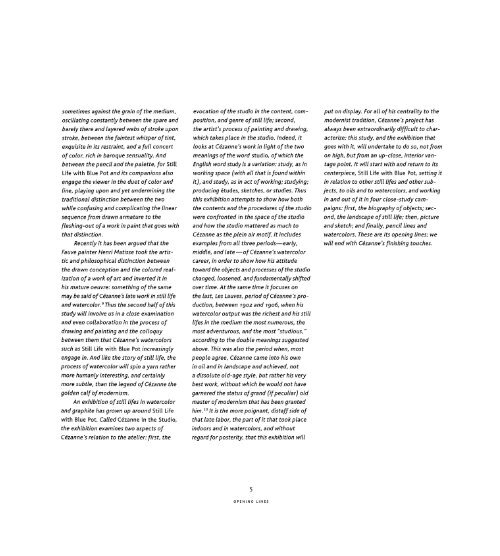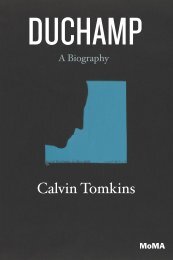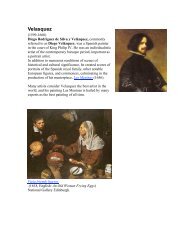Still Life in Watercolors
qbj8dgc
qbj8dgc
- No tags were found...
Create successful ePaper yourself
Turn your PDF publications into a flip-book with our unique Google optimized e-Paper software.
sometimes aga<strong>in</strong>st the gra<strong>in</strong> of the medium,<br />
oscillat<strong>in</strong>g constantly between the spare and<br />
barely there and layered webs of stroke upon<br />
stroke, between the fa<strong>in</strong>test whisper of t<strong>in</strong>t,<br />
exquisite <strong>in</strong> its restra<strong>in</strong>t, and a full concert<br />
of color, rich <strong>in</strong> baroque sensuality. And<br />
between the pencil and the palette, for <strong>Still</strong><br />
<strong>Life</strong> with Blue Pot and its companions also<br />
engage the viewer <strong>in</strong> the duet of color and<br />
l<strong>in</strong>e, play<strong>in</strong>g upon and yet underm<strong>in</strong><strong>in</strong>g the<br />
traditional dist<strong>in</strong>ction between the two<br />
while confus<strong>in</strong>g and complicat<strong>in</strong>g the l<strong>in</strong>ear<br />
sequence from drawn armature to the<br />
flesh<strong>in</strong>g-out of a work <strong>in</strong> pa<strong>in</strong>t that goes with<br />
that dist<strong>in</strong>ction.<br />
Recently it has been argued that the<br />
Fauve pa<strong>in</strong>ter Henri Matisse took the artistic<br />
and philosophical dist<strong>in</strong>ction between<br />
the drawn conception and the colored realization<br />
of a work of art and <strong>in</strong>verted it <strong>in</strong><br />
his mature oeuvre: someth<strong>in</strong>g of the same<br />
may be said of Cezanne's late work <strong>in</strong> still life<br />
and watercolor. 9 Thus the second half of this<br />
study will <strong>in</strong>volve us <strong>in</strong> a close exam<strong>in</strong>ation<br />
and even collaboration <strong>in</strong> the process of<br />
draw<strong>in</strong>g and pa<strong>in</strong>t<strong>in</strong>g and the colloquy<br />
between them that Cezanne's watercolors<br />
such as <strong>Still</strong> <strong>Life</strong> with Blue Pot <strong>in</strong>creas<strong>in</strong>gly<br />
engage <strong>in</strong>. And like the story of still life, the<br />
process ofwatercolor will sp<strong>in</strong> a yarn rather<br />
more humanly <strong>in</strong>terest<strong>in</strong>g, and certa<strong>in</strong>ly<br />
more subtle, than the legend of Cezanne the<br />
golden calf of modernism.<br />
An exhibition of still lifes <strong>in</strong> watercolor<br />
and graphite has grown up around <strong>Still</strong> <strong>Life</strong><br />
with Blue Pot. Called Cezanne <strong>in</strong> the Studio,<br />
the exhibition exam<strong>in</strong>es two aspects of<br />
Cezanne's relation to the atelier: first, the<br />
evocation of the studio <strong>in</strong> the content, composition,<br />
and genre of still life; second,<br />
the artist's process of pa<strong>in</strong>t<strong>in</strong>g and draw<strong>in</strong>g,<br />
which takes place <strong>in</strong> the studio. Indeed, it<br />
looks at Cezanne's work <strong>in</strong> light of the two<br />
mean<strong>in</strong>gs of the word studio, of which the<br />
English word study is a variation: study, as <strong>in</strong><br />
work<strong>in</strong>g space (with all that is found with<strong>in</strong><br />
it), and study, as <strong>in</strong> act of work<strong>in</strong>g; study<strong>in</strong>g;<br />
produc<strong>in</strong>g etudes, sketches, or studies. Thus<br />
this exhibition attempts to show how both<br />
the contents and the procedures of the studio<br />
were confronted <strong>in</strong> the space of the studio<br />
and how the studio mattered as much to<br />
Cezanne as the ple<strong>in</strong> air motif. It <strong>in</strong>cludes<br />
examples from all three periods—early,<br />
middle, and late — of Cezanne's watercolor<br />
career, <strong>in</strong> order to show how his attitude<br />
toward the objects and processes of the studio<br />
changed, loosened, and fundamentally shifted<br />
over time. At the same time it focuses on<br />
the last, Les Lauves, period of Cezanne's production,<br />
between 7902 and 1906, when his<br />
watercolor output was the richest and his still<br />
lifes <strong>in</strong> the medium the most numerous, the<br />
most adventurous, and the most "studious,"<br />
accord<strong>in</strong>g to the double mean<strong>in</strong>gs suggested<br />
above. This was also the period when, most<br />
people agree, Cezanne came <strong>in</strong>to his own<br />
<strong>in</strong> oil and <strong>in</strong> landscape and achieved, not<br />
a dissolute old-age style, but rather his very<br />
best work, without which he would not have<br />
garnered the status of grand (if peculiar) old<br />
master of modernism that has been granted<br />
him. 10 It is the more poignant, distaff side of<br />
that late labor, the part of it that took place<br />
<strong>in</strong>doors and <strong>in</strong> watercolors, and without<br />
regard for posterity, that this exhibition will<br />
put on display. For all of his centrality to the<br />
modernist tradition, Cezanne's project has<br />
always been extraord<strong>in</strong>arily difficult to characterize:<br />
this study, and the exhibition that<br />
goes with it, will undertake to do so, not from<br />
on high, but from an up-close, <strong>in</strong>terior vantage<br />
po<strong>in</strong>t. It will start with and return to its<br />
centerpiece, <strong>Still</strong> <strong>Life</strong> with Blue Pot, sett<strong>in</strong>g it<br />
<strong>in</strong> relation to other still lifes and other subjects,<br />
to oils and to watercolors, and work<strong>in</strong>g<br />
<strong>in</strong> and out of it <strong>in</strong> four close-study campaigns:<br />
first, the biography of objects; second,<br />
the landscape of still life; then, picture<br />
and sketch; and f<strong>in</strong>ally, pencil l<strong>in</strong>es and<br />
watercolors. These are its open<strong>in</strong>g l<strong>in</strong>es; we<br />
will end with Cezanne's f<strong>in</strong>ish<strong>in</strong>g touches.<br />
5<br />
OPENING LINES




